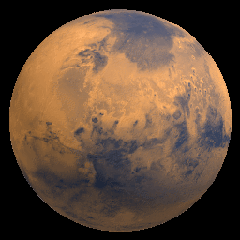Water on Mars?
Air Date: Week of January 5, 2007

(Courtesy of NASA)
A recent round of discoveries made by NASA robots indicates there might be flowing water under the surface of Mars. And where there's water there may be life. Astrophysicist Neil deGrasse Tyson talks with host Bruce Gellerman about the search for living organisms on Mars.
Transcript
GELLERMAN: It’s Living on Earth. I’m Bruce Gellerman. Does a river run through it? “It” in this case, being Mars. Three years ago, the U.S. sent two small robots to the surface of the red planet. They’re called “Spirit” and “Opportunity” and they’ve been roving ever since under the watchful eye of an orbiting NASA satellite.
Recently, the intrepid explorers made a series of tantalizing discoveries. High-resolution images of gullies and a number of sediment samples suggest flowing water on the planet.
The big question now for scientists is to determine whether or not water is currently on the move on Mars. And the even bigger question: does water indicate the presence of Martian life? For answers we turn to Neil deGrasse Tyson. He's an astrophysicist and director of the Hayden Planetarium in New York City and a frequent contributor to Living on Earth. Hi, Dr. Tyson.
TYSON: A pleasure to be back.
GELLERMAN: So haven’t scientists known for a while that water has played a role in the history and formation of mars?

Mars (Courtesy of NASA)
GELLERMAN: So we now know that there’s water on Mars?
TYSON: Well, what you want is firm evidence not this circumstantial kind. And so the Mars rovers targeted regions of the red planet where we suspected they would find evidence; rocks that formed in standing water and in fact that was indeed found. That was considered a triumph, confirmed our suspicions of what must have been going on on Mars all along. So we then said, “Alright, we know Mars once had water. Is it still there and in what form might it exist?”
And the recent discoveries of the Mars global surveyor, which by the way has many many years of a base line of photographic imagery of the Martian surface, and what they did was compare pictures from 1999 to pictures most recently taken just before we lost contact with the craft. And what we found is that there’s a place that shows evidence of there having been running water. There’s a freshly made gully at the side of one of the craters.
GELLERMAN: So between 1999 and now there was water flowing?

Sedimentary rock layers like these in Mars's Holden Crater suggest that the Red Planet was once home to ancient lakes. (Courtesy of NASA)
GELLERMAN: Well, if there was liquid water, where’d it go and where is it?
TYSON: Well, the best ideas are that it, the water is deep beneath the Martian surface. But Mars is so cold that nobody expects this water to be liquid. It would surely be frozen like the permafrost that you find in the northern slopes of Alaska. So, that’s where we suspected the water had gone on Mars. And so here we have evidence of liquid water oozing out from the side of this crater. And it’s still a mystery of what could have liquefied it. Is there a heat source that is yet to be discovered? Some radioactivity that’s warming one zone compared with another? Are the pressures so great beneath the Martian surface that it has turned the solid into liquid? That’s something that is possible.
GELLERMAN: So, how do we know that it’s water and not some other liquid that caused these features?
TYSON: That’s an excellent question. There are other liquids one can imagine like ammonia. Water and ammonia, they’re not the only liquids in town. It turns out water is abundant. There’s no shortage of water in the universe. Water is composed, as we remember from elementary school, H2O; you know hydrogen and oxygen. These are two of the most top three most common ingredients in the universe. So to suppose some other ingredient you’d have to sort of jump through hoops for that where as you kind of get water for free.

Neil deGrasse Tyson is director of New York’s Hayden Planetarium (Courtesy of Patrick Queen© Reprinted by permission of Prometheus Books)
TYSON: (laughing) So why spend billions to find it on Mars?
GELLERMAN: Precisely.
TYSON: Um, the issue is not simply whether there’s water. We should think of water as a tracer of our greatest scientific dreams of discovery. Water would be a tracer for the possibility of life.
GELLERMAN: But all of the life that we know of on earth is carbon based, it’s organic. Would we know life if it was based say on silicon or potassium?
TYSON: That’s an interesting question. You know if it crawls out of the cave it’s life. (laughing) You know if the thing bites you somewhere, you know. No but that’s an interesting question. Is our definition of life so biased that we might miss it if it stares us in the face? But I think if you just get practical in a lab it shouldn’t be too hard to find out if something is alive. If it’s alive it has a metabolism. It might have a way to reproduce its self. It consumes energy. These are the kinds of basic and simple functions of life. And if we find that on Mars, even if it’s not carbon based, it shouldn’t be too hard to identify.
GELLERMAN: Didn’t scientists back in the ‘90s discover meteorites in Antarctica that they thought carried fossilized remains of bacteria from Mars?
TYSON: Yeah, good memory there. Actually that meteorite was discovered in 1984. But it was unknown whether it had any important significance until the 1990s where it was discovered to have come from Mars, number one. Number two, to have evidence of stow away bacteria. The actions of bacteria imbedded in the nooks and crannies of the rock. What’s fascinating is if you combine the fact that you have hearty bacteria and rocks that move between planets it allows you to suggest that maybe life started on Mars before it started on Earth. And if so maybe these stow away bacteria seeded life on Earth, making all life on Earth descendents of Martians.
GELLERMAN: Well, the bigger question is: is it possible that there’s still life on Mars?
TYSON: That’s a bigger question. And here’s something interesting: if you find life and it’s DNA based you don’t know whether we are descendents of it or they’re descendants from us. Or whether DNA is some fundamental feature of life no matter where you find it in the universe. It’d be more fun if the life on Mars had some completely other kind of basis for chemistry. But it’s probably not likely because carbon is an extremely fertile element of the periodic table. It combines with everybody all kinds of ways. It combines with itself. It makes long molecules, short molecules. If you want the most fertile chemistry on which to experiment with life, carbon based chemistry is your choice.
GELLERMAN: I think many people’s image of Mars the solar system is of a static place. But the new evidence suggests that Martian climate is very complex and it actually is changing.
TYSON: Yeah, many people don’t know that in fact Mars rotates once every 24 hours on its axis. It’s axis is tipped like Earth’s axis is, which means it goes through seasons. And Mars has polar ice caps that ebb and grow and shrink with the seasons. And it has dust storms that change the visibility of it’s surface and alter surface features. And now we know there’s water erosion on its surface. So yes, it is a dynamic place. We’re so accustomed to looking and thinking about the moon and how dead a place it is and so not all the solar system is dead. And by the way Mars once had water and it doesn’t now. Something bad happened on Mars. Some knob got turned in the conditions on the Martian surface for it to have lost all its water. I want to know what knobs we’re turning here on Earth so I can safe guard our water supply so we don’t end up looking like Mars.
GELLERMAN: Dr. Tyson, it’s always a pleasure.
TYSON: Thanks for having me. And it’s always a pleasure to be on Living on Earth. Maybe one day there will be a program called Living on Mars.
GELLERMAN: Astrophysicist Neil deGrasse Tyson hosts the PBS TV series "Nova Science Now" and is author of the new book “"Death by Black Hole and other Cosmic Quandaries."
Links
NASA’s Mars Exploration Program
Living on Earth wants to hear from you!
Living on Earth
62 Calef Highway, Suite 212
Lee, NH 03861
Telephone: 617-287-4121
E-mail: comments@loe.org
Newsletter [Click here]
Donate to Living on Earth!
Living on Earth is an independent media program and relies entirely on contributions from listeners and institutions supporting public service. Please donate now to preserve an independent environmental voice.
NewsletterLiving on Earth offers a weekly delivery of the show's rundown to your mailbox. Sign up for our newsletter today!
 Sailors For The Sea: Be the change you want to sea.
Sailors For The Sea: Be the change you want to sea.
 The Grantham Foundation for the Protection of the Environment: Committed to protecting and improving the health of the global environment.
The Grantham Foundation for the Protection of the Environment: Committed to protecting and improving the health of the global environment.
 Contribute to Living on Earth and receive, as our gift to you, an archival print of one of Mark Seth Lender's extraordinary wildlife photographs. Follow the link to see Mark's current collection of photographs.
Contribute to Living on Earth and receive, as our gift to you, an archival print of one of Mark Seth Lender's extraordinary wildlife photographs. Follow the link to see Mark's current collection of photographs.
 Buy a signed copy of Mark Seth Lender's book Smeagull the Seagull & support Living on Earth
Buy a signed copy of Mark Seth Lender's book Smeagull the Seagull & support Living on Earth

